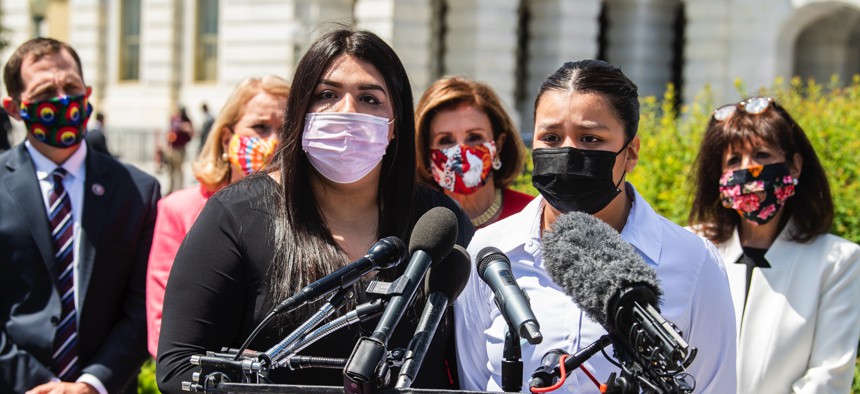
The sisters of Vanessa Guillen—Lupe, right, and Mayra—speak during a news conference outside the Capitol about legislation to allow military victims of sexual harassment and assault to report incidents outside the chain of command on May 13, 2021. Tom Williams/CQ-Roll Call, Inc via Getty Images
It’ll Be ‘Years’ Before the Pentagon Fully Implements Changes to Handling Sexual Assaults
Congress has directed several major changes to the way the military handles sexual assault. Officials say full implementation remains several years away.
Part 2 of "The Threat Within," a three-part series on sexual assault in the U.S. military. Read Part 1 and Part 3.
The Pentagon is years away from fully implementing the changes to its military justice system and sexual assault prevention and response programs that Congress ordered last December, service officials say.
Some of that is by design. The 2022 National Defense Authorization Act gave the military services until Dec. 27, 2023, to create a special trial counsel, which will take most prosecution authority away from military commanders for 11 crimes, including sexual assault and murder. Those new prosecution offices should be “up and running by June, so when the new program goes live at the end of 2023, that they’re ready,” Sen. Kirsten Gillibrand, D-N.Y., told reporters Wednesday.
But other changes are simply overdue. The Pentagon has yet to fully implement 36 of the 198 sexual-assault related statutory requirements that Congress passed between 2004 and 2019, according to a March 2022 Government Accountability Office report.
There’s no time to waste, said Gillibrand, who sponsored clauses in the 2023 defense authorization bill now under consideration to extend the purview of the new prosecutor’s offices. “For every one of these assaults, you are undermining good order and discipline at its very core,” she said.
Representatives for the services agree that comprehensive change is necessary to reverse the upward trend of military sexual assaults. But they say such extensive reform simply takes time.
Army
The impetus for an overhaul of the way the military handles sexual assault was the 2020 murder of Spc. Vanessa Guillen, the social media movement that shamed the Army into investigating it, and the report of the Fort Hood Independent Review Committee.
That report served as a “line of demarcation” for the Army, and since its release, the service has made “significant changes to the way that it counters harmful behaviors,” as well as altered its sexual assault and harassment training and “doubled down on our battalion and brigade-level commander selection process” to choose leaders who are “better suited to building positive command climates,” Army Undersecretary Gabe Camarillo told the House Armed Services Committee in September.
Camarillo spoke just weeks after the Pentagon released its annual report on sexual assault in the military, revealing that the Army had received 4,081 reports of sexual assault in fiscal 2021—a 25 percent increase from the previous year.
“The Army has made a serious commitment to change,” the undersecretary told lawmakers, noting that his service had implemented 63 of the 70 recommendations from the Fort Hood report and four of the six “priority” recommendations assigned to the Army by the Pentagon’s Independent Review Commission.
James Helis, director of the Army Resilience Directorate, told Defense One that the service is taking “a much more integrated and holistic approach to the prevention of harmful behaviors,” focusing on “a whole spectrum” of behaviors, including sexual assault, suicide, domestic violence, child abuse, and other crimes.
Helis said that it will take years to implement the new approach. It’s “not just a reaction to crisis,” he said, but an “intentional, long-term, multidimensional strategy to both get at these behaviors and institutionalize the changes that are required, so that we don’t...continue this cycle of crisis-and-response.”
The three biggest changes for the Army are creating the special trial counsel, restructuring the service’s sexual assault and prevention workforce, and creating and staffing integrated prevention advisory groups. The latter will have specialized experience in prevention, Helis said, and will examine all the data the installations have, assess risks, provide recommendations for how to reduce those risks, and help commanders design and implement recommended programs.
The Army has also added added a screening process process for potential battalion- and brigade-level commanders, Helis said. It looks at communication skills, empathy, and other “leadership traits that don’t necessarily appear in the electronic files the boards look at,” and is meant to determine “is this individual really ready for command.” He said the new screening has already yielded results.
“Nobody wants to see sexual assaults or suicides or poor climate. Nobody wants to see that in their units. What we need to do a better job of is equipping our commanders with the knowledge about how to get after prevention within their formations,” he said. “The will is there. The desire is there. We need to do a better job of providing commanders and leaders the tools they need, so they can actually get upstream of these problems..”
Navy and Marine Corps
In fiscal 2021, there were 1,883 reports of sexual assault in the Navy, a 9.2 percent increase from the previous year. The Marine Corps had 1,202 reports, up 2 percent.
But long-term data on military sexual assault indicates that “this is a solvable problem,” said Andrea Goldstein, acting director of the Navy Department’s Office of Force Resiliency (known until August as the Sexual Assault Prevention and Response Office). “It is a big problem, but there are definitely things that we can do.…We need to take a holistic approach. We can’t just train people once a year and talk solely about response without addressing prevention. We need to address the culture in which these issues are, in which these crimes take place.”
In June, the Navy Department implemented a “Safe-to-Report” policy, which states that troops who report being sexually assaulted cannot be disciplined for related minor misconduct, including underage drinking around the time of the alleged assault or an unprofessional relationship with the accused.
The policy “eliminates a significant barrier,” Goldstein said. “Reporting a sexual assault can be a terrifying experience. And a victim or survivor of sexual assault should not fear that they will be punished for bravely coming forward.”
The department also created an implementation advisory panel that has allowed the Navy to move quickly on some of the Congressionally mandated sexual assault-related changes, including implementing a change to sexual harassment investigations 18 months earlier than required, Goldstein said, and enacting a “No Wrong Door” policy that allows victims to get help and support even if the agency they initially approach is not the officially correct agency to provide that assistance.
Like the Army, the Navy is hiring dozens of sexual-assault-prevention workers. And several other programs—as well as the shift of prosecutorial responsibility to special trial counsels—are still in the works. But the issue of sexual assault does not come down to just one policy or program, Goldstein said. “It’s a constellation of issues that address accountability and victim care and climate and culture. So what you want to do is you want to create a framework where you can address that holistically.”
Air Force and Space Force
In fiscal 2021, the Department of the Air Force had 1,700 reports of sexual assault, up 2 percent from the previous year “and the highest recorded value in the 14-year history of the SAPR program,” according to the branch’s annual report. Department officials suggested the increase may be due to victims feeling more comfortable coming forward.
The Air Force also has started several new programs, including one that brings together various response resources and offices into a sort of “one-stop shop,” where victims of sexual assault, sexual harassment, domestic violence, or stalking can go to get the services they need, said Andrea Bryant, deputy director of the department’s Integrated Resilience Office. That pilot program started Aug. 1 at seven installations, and will run until the end of January.
Another related program is “all about ensuring that anyone who comes forward to receive help never hears, ‘I’m not the right person to help you,’” Bryant said. And the department has expanded their victim-advocacy-support services to include victims of sexual harassment as well as of sexual assault.
But she said there is “a lot” more to come focusing on prevention, including a dedicated prevention workforce of more than 400 new employees. Though all the services must hire a prevention team, Bryant said the Air Force “kind of led the way,” in that it already—since 2015—had violence prevention workers who were focused on suicide prevention, so they expanded the program to include sexual assault, sexual harassment, domestic violence, workplace violence, child abuse, and other related crimes.
“It is a multi-phased approach that’s going to take us until 2026 to fully implement and bring everybody on board,” but the team will focus on “research-based prevention practices” that have been shown to work, she said.
“We don't just want to be doing something to be doing something. We want to make sure we're doing the right something that's going to have the results desired: actually preventing these behaviors,” Bryant said. “We’re responsible for cultivating a culture of dignity and respect, where all feel welcome and supported, and where those corrosive behaviors aren't tolerated. And when you have sexual assault occur, it breaks that down. How do you feel like you're in a culture of dignity and respect when an assault or harassment is occurring in the unit?”
A year and a half after the Independent Review Commission released its report, the services still have a lot to do. And Bryant said that from her perspective, “Time is not on our side, because everybody wants everything yesterday.”
Still, she said, she believes that “we’re going to see things get a lot better over the course of the next several years. It’s just the time to actually implement [the new programs] and get them up and running. And most of them are going to take four or five years of building up the workforce and building up the resources and being able to implement them and have them be sustainable.”


